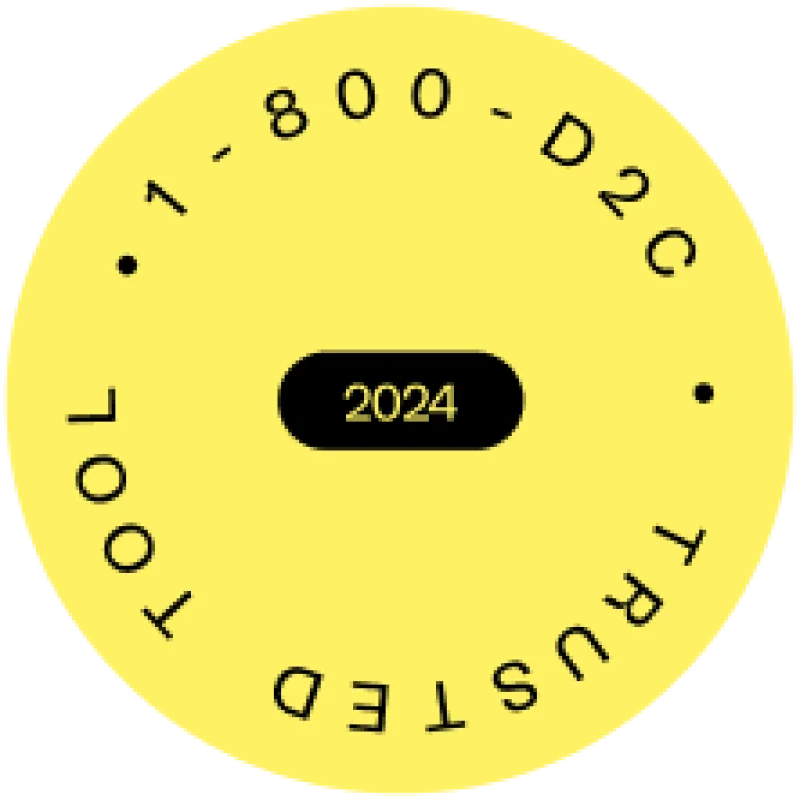Best Sales & Use Tax Software for 2026: Compare Top Tools
05 November
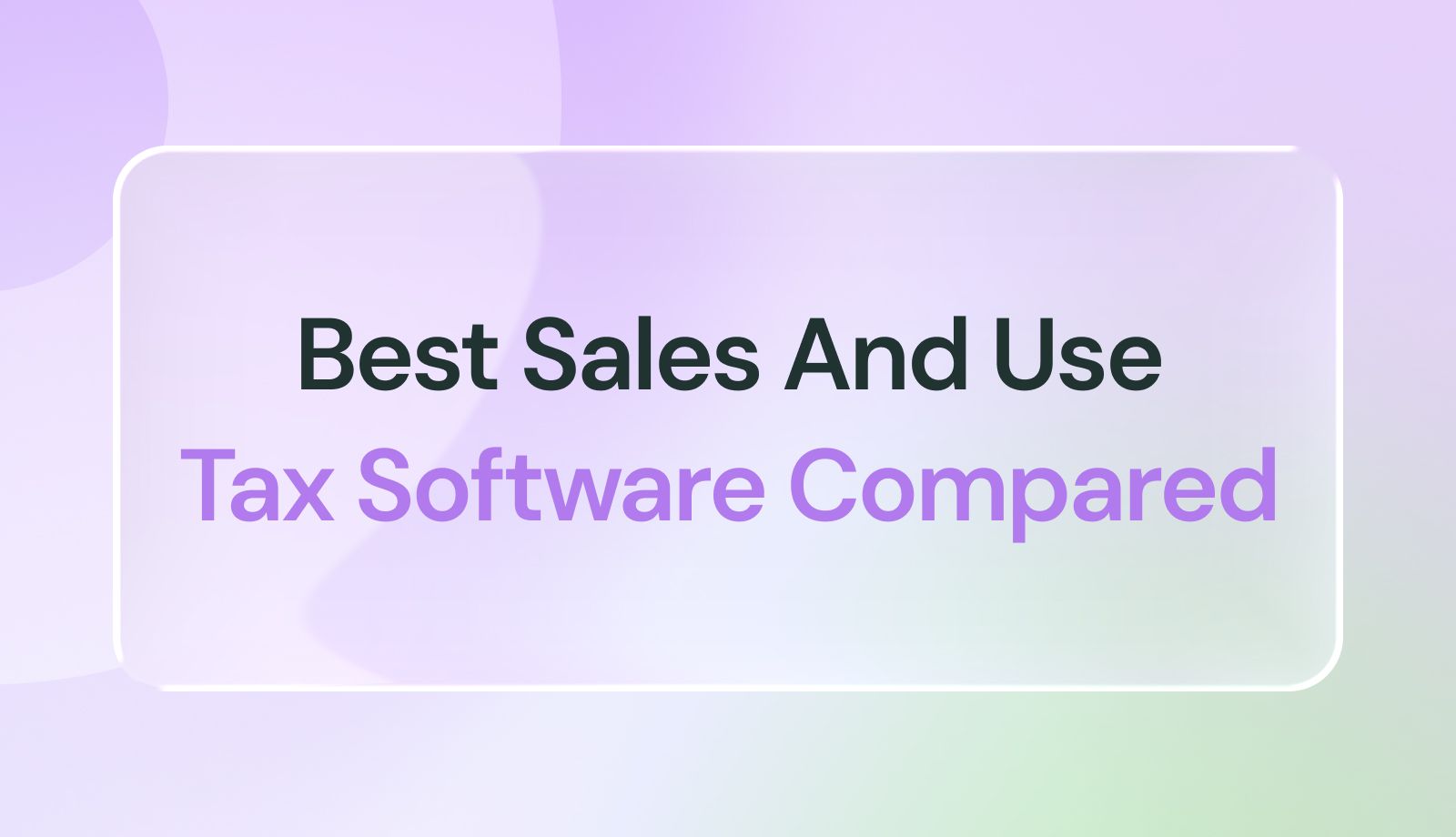
Ready to automate your sales tax?
Sign up for free
Fast-moving commerce has been compelling organisations to go beyond selling in just one state or through a single channel. They’re selling across the U.S., expanding into new states, licensing digital goods internationally, and also buying from other states or overseas. That means both sales tax (when you sell) and use tax (when you buy/receive goods/services without tax) are on the radar. This complexity is rising fast.
Looking ahead to 2026, the trends are clear: more digital-goods taxation, evolving nexus laws, and increased audit activity. That makes selecting the best sales and use tax software a strategic business choice.
This article is for decision-makers in finance, operations, or tax who are in the evaluation phase of software selection. We compare the best sales and use tax software, highlight what to look for, and help you choose the right one.
Why Tax-Software Selection Matters
Given the following trends, picking the best sales and use tax software now is a way to prevent future issues, rather than reacting later:
Digital goods taxation
As more businesses sell software subscriptions, SaaS services, downloads, and other digital goods, tax authorities are catching up. For example, the U.S. states are increasingly defining “digital goods” or “digital services” as taxable. Thus, your tax software choice must handle digital goods taxability rules, not just “physical goods” across states.
Evolving nexus (sales & use)
The concept of nexus (the connection that triggers tax obligations) continues to evolve. For example, economic nexus, marketplace facilitator laws, and thresholds triggering registration in states where you don’t have a physical presence. In 2025, more than 13,000 U.S. taxing jurisdictions exist, making manual compliance untenable. Thus, your sales and use tax compliance software must support cross-jurisdictional coverage and be future-ready.
Increased audit & regulatory focus
Because tax authorities are under pressure to collect revenue, audit activity is increasing for businesses with multi-state footprints, digital goods exposure, or use-tax liabilities. These are often overlooked. The implication: sales and use tax software solutions must calculate correctly and provide audit trails, exemption-certificate management, purchase-side tracking (use tax), and filing support.
What to Look For in a Sales & Use Tax Software
Here are the six key criteria you should evaluate:
1. Automation & Accuracy
You want tools that automatically calculate tax in real-time, correctly apply product-taxability rules, track where you have nexus, and minimize manual errors in filing. For example, the sales tax automation should extend to tracking purchase transactions that may trigger use-tax obligations, even if you don’t automate use-tax filings right now.
2. Cross-Jurisdiction Coverage
The best tools provide end-to-end coverage across all U.S. states for both sales tax and use tax accruals where applicable. This means whether you’re selling into multiple states or buying/receiving from multiple states, the platform handles both sides.
3. Integrations & Tech Stack Fit
Your tax software does not live in isolation. It must integrate natively with your billing systems, such as Stripe and Chargebee; ecommerce platforms, such as Shopify and WooCommerce; and accounting or ERP tools, such as QuickBooks and NetSuite; and ideally capture your purchase-side transactions as well.
4. Filing & Remittance Support
Beyond calculations, your platform needs strong features for filings, remittances, consolidated reporting across states, management of exemption certificates, and transaction-level audit trails. Some advanced systems also support the preparation of use-tax returns, which is worth noting when evaluating enterprise options.
5. Pricing Transparency & Scalability
You want predictable, usage-based pricing and native scalability as your business expands in states, channels, or purchase volumes. If you expect to manage use-tax accruals later, look for platforms that offer add-on modules or API extensibility, rather than requiring a platform migration.
6. Support, Onboarding & Future Readiness
Don’t overlook your latent use-tax risk. This arises when you buy out-of-state goods without paying sales tax upfront. Tax rules evolve quickly, especially for digital goods, nexus laws, and cross-border services. Choose a partner that provides expert guidance, alert systems, and a roadmap aligned with your future needs, including potential use-tax capabilities.
Top 8 Sales & Use Tax Software Solutions
Here are eight strong options. You’ll want to map your business size, channel complexity, and purchase risk to the vendor fit.
1. Kintsugi – AI-Driven Compliance for Sales Tax
Kintsugi offers AI-powered automation focused on U.S. sales tax compliance today. Built for growth and scalability.
Key Features:
-
Real-time sales tax calculation, nexus monitoring, filings automation, dashboards + alerts.
-
Integrations: Billing platforms, ecommerce platforms, APIs for modern stacks.
-
Pricing: Clear usage-based model; free monitoring tier available; flat fee per filing.
-
Best For: Growth-stage SaaS & ecommerce companies that value automation, clarity, and a modern UI.
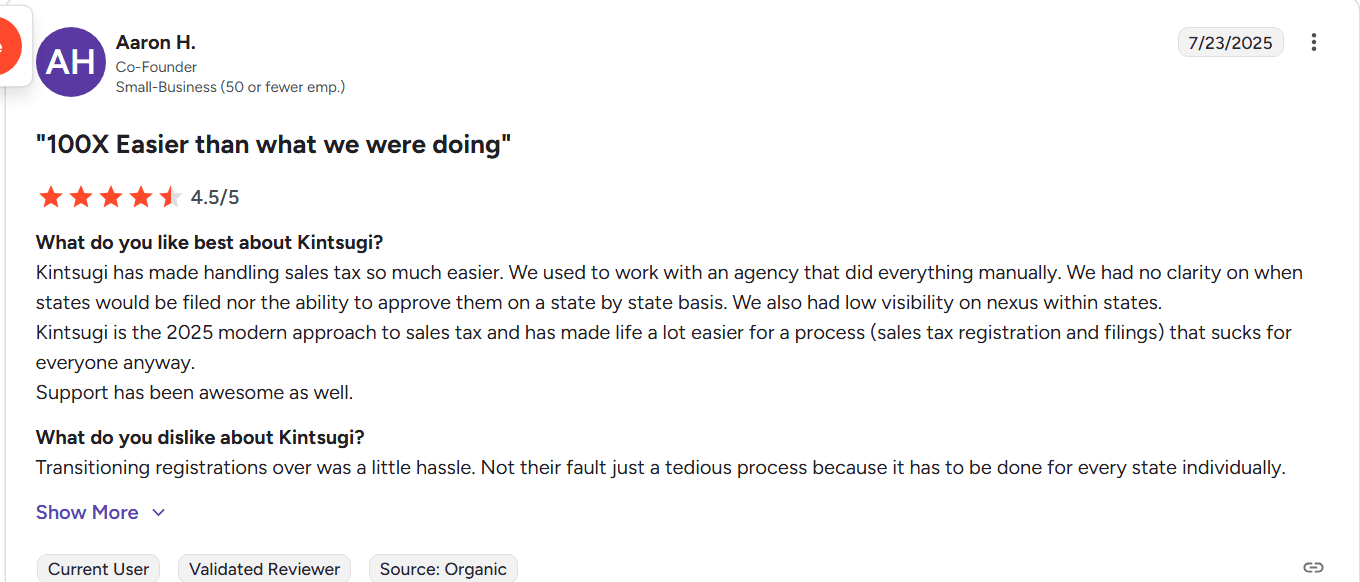
2. Avalara – Established Leader for Broad Tax Compliance
A long-standing major player in indirect tax compliance. Strong in sales & use tax, international VAT/GST, cross-border.
-
Key Features: Real-time rooftop accuracy tax calculations, wide coverage of tax types (sales, use, VAT, and GST).
-
Integrations: Over 1,000 (or more) partner integrations across ERPs, ecommerce, and billing.
-
Pricing: Volume-based; setup fees. For example, registration service costs $403 per location.
-
Best For: Mid- to large-sized enterprises, companies with complex indirect tax needs, or global footprints.
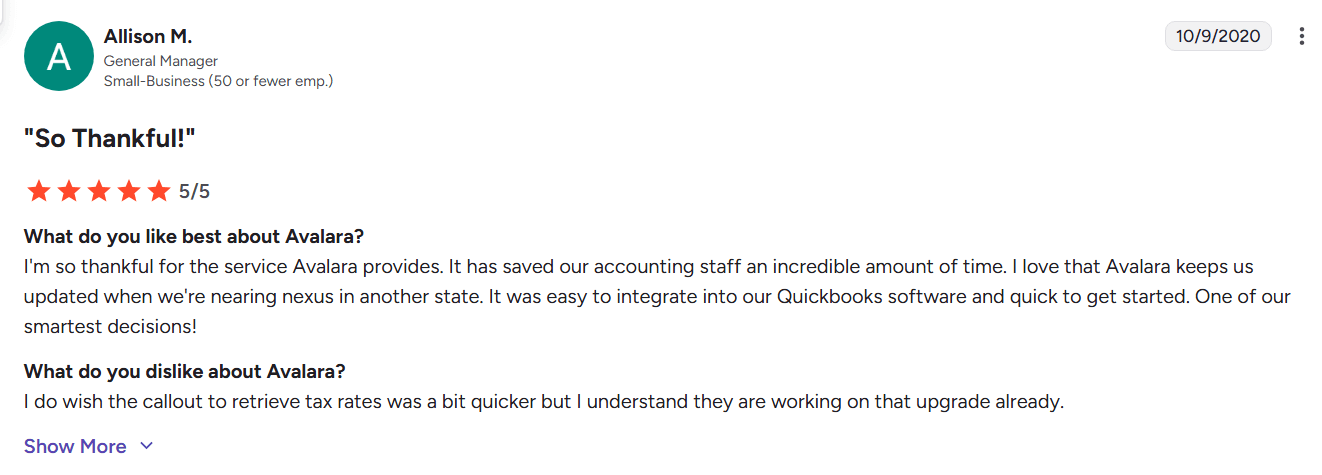
3. Vertex – Enterprise-Grade Tax Engine
Built for enterprise-scale and high-complexity environments. Supports many jurisdictions, global tax types.
-
Key Features: Massive tax rule database, robust calculation and reporting engine.
-
Integrations: Enterprise ERP/ERP-adjacent systems; heavier implementation.
-
Pricing: Expect a higher implementation cost and significant internal resources.
-
Best For: Large enterprises (multi-state, multi-country), with an internal tax department and high compliance overhead.

4. Sovos – Compliance-Focused Large-Organisation Solution
Tailored to large orgs with complex regulatory demands like manufacturing, finance, and cross-border.
-
Key Features: Centralised compliance reporting, returns management, global tax coverage.
-
Integrations: Enterprise platforms, global tax engines.
-
Pricing: Premium.
-
Best For: Large organisations with high-volume transactions, a global supply chain, and multiple tax types.

5. Quaderno – Multi-Channel / Digital Goods Specialist
Designed especially for online businesses like SaaS and ecommerce selling digital goods, supporting US sales tax + global VAT/GST.
-
Key Features: Real-time monitoring of thresholds, automatic tax calculations for digital goods, and global jurisdiction support.
-
Integrations: One-click with payment gateways, ecommerce platforms, Zapier, etc.
-
Pricing: Attractive for smaller-to-mid-sized businesses; plans start at ~$29/month.
-
Best For: Online companies selling digital goods or services globally; those with multi-channel/marketplace operations.

6. LOVAT – International / Global Tax Support
Focus on VAT, GST, and sales tax for international sellers (especially marketplace sellers).
-
Key Features: Designed for cross-border compliance.
-
Integrations: Ecommerce, marketplaces.
-
Pricing: Competitive for small global sellers.
-
Best For: Sellers with international sales, foreign entities, and digital products.

7. Zamp – Emerging Platform with Automation Focus
A newer entrant focused on automated workflows, an API-first approach for ecommerce/SaaS.
-
Key Features: Developer-friendly, integration-focused.
-
Pricing: Premium but simpler model.
-
Best For: Tech-forward companies with custom stacks and a willingness to integrate via API.
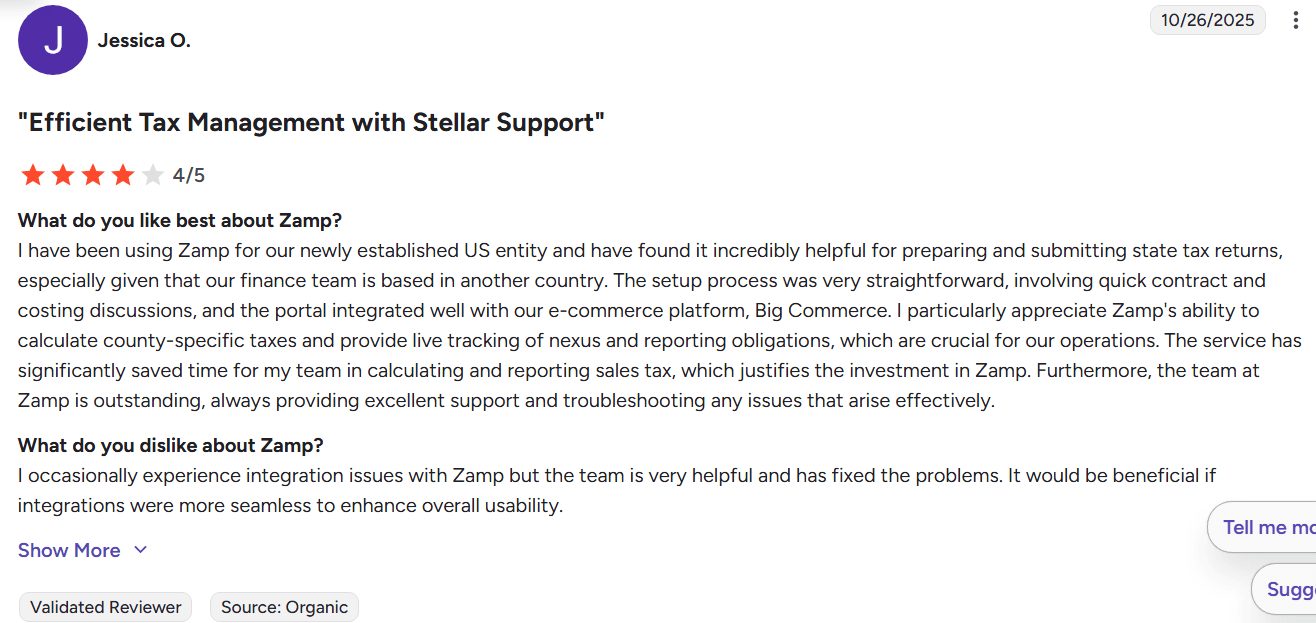
8. ONE SOURCE Indirect Tax (by Thomson Reuters) – Full-Suite Enterprise Compliance
Comprehensive indirect tax solution including sales, use, VAT, excise, and global tax types.
-
Key Features: Global tax engine, complex reporting, and audit defense.
-
Integrations: Enterprise ERP, tax departments.
-
Pricing: High-end enterprise.
-
Best For: Large corporations with a global footprint, indirect tax complexity, and complex supply chains.
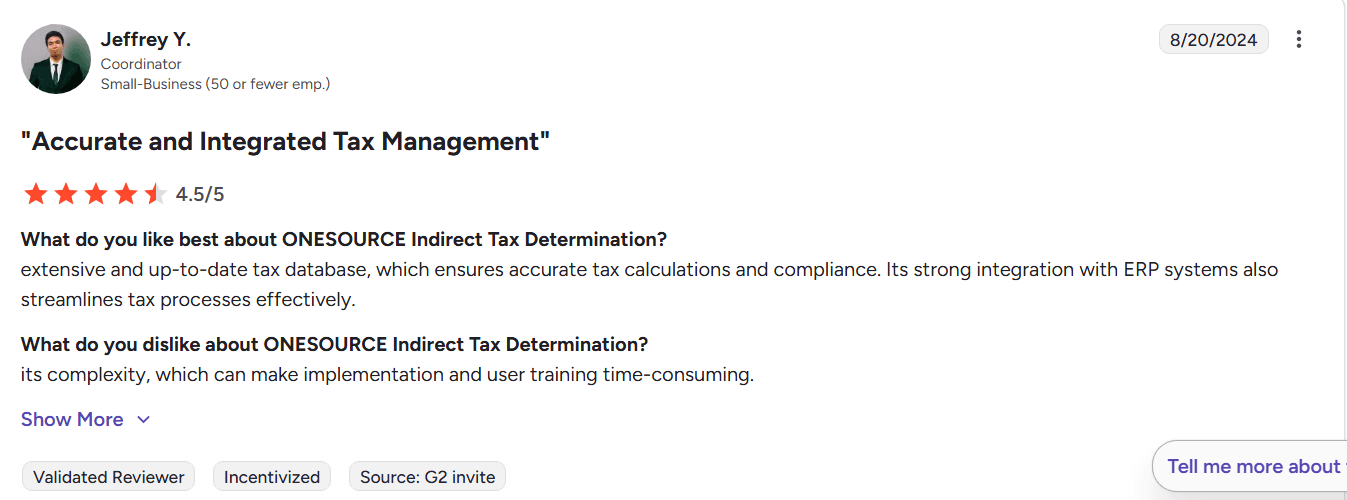
Stop stressing over tax complexity — let AI-powered automation handle it for you.
How to Choose the Right Tool for Your Business
| Vendor | Automation Level | Use-Tax Support | Integrations | Cost Tier | Best Fit Company Size / Complexity |
|---|---|---|---|---|---|
| Kintsugi | High | Moderate | Strong (modern stack) | Lower-mid | Growth SaaS / ecommerce |
| Avalara | High | Strong | Very strong (1,000+ apps) | Mid-enterprise | Mid-large businesses |
| Vertex | Very High | Very strong | Enterprise ERP stack | High | Large enterprise |
| Sovos | High | Strong | Enterprise | High | Large/regulated industries |
| Quaderno | Mid-High | Good (digital) | Ecommerce/marketplace | Lower-mid | SaaS/digital goods/global sellers |
| LOVAT | Mid | Good (global) | Marketplace sellers | Lower | International sellers |
| Zamp | High | Emerging | API-first | Mid-high | Tech stack implements |
| ONE SOURCE Indirect | Very High | Comprehensive | Enterprise | Very High | Global conglomerates |
Key Questions to Ask Yourself
-
How many jurisdictions, states + local, do we currently transact in?
-
How many states have we triggered nexus in or expect to?
-
Do we have significant use-tax risk, i.e., out-of-state purchases, drop-ship, remote workforce, and procurement from other states?
-
What is our tech stack? Do we use Stripe, Chargebee, Shopify, NetSuite, or QuickBooks? Are there custom flows?
-
What is the volume and complexity of transactions like digital goods, multi-channel, marketplaces, and international?
-
What scale do we expect in the next 12-24 months? Any new channels, new states, procurement growth?
-
What budget do we have, and which pricing model —usage-based, flat fee, or modular add-ons —works for us?
-
How quickly do we need to go live? What internal resources, like tax, ops, or IT, can we allocate?
-
What’s the vendor’s support model & roadmap? Are they ready for digital goods, use tax, or global expansion?
Onboarding & Timeline
Certain sales and use tax accounting software can be deployed quickly, especially those built for modern SaaS/ecommerce, such as Kintsugi or Quaderno. But enterprise sales and use tax automation software may require significant setup, internal tax resources, and IT/ERP work.
So, consider data clean-up for transaction history or purchase data, product taxability mapping, integration work, exemption certificate set-up, training, and change management. Also, aim for a pilot/state then scale approach if possible.
Red Flags
-
Hidden fees like per-state filings and consult services.
-
Limited jurisdiction coverage. For example, only 40 states, no use-tax module.
-
Poor integration with your stack or heavy custom coding required.
-
No support for purchase-side/use-tax tracking, if you have that risk.
-
Vendor doesn’t support digital goods or evolving nexus laws.
-
Pricing model lacks clarity or is usage-blind. So, you get surprised as you scale.
Final Thoughts & Next Steps
In 2025-26, managing both sales tax and use tax is unavoidable for growth companies responding to digital-goods models, multi-state activity, and increased audit risk. Manual spreadsheets or piecemeal legacy tools are not enough. Automation, integration, accuracy, and future scalability matter for sales and use tax calculation software.
Kintsugi offers a modern approach with strong automation and a clean stack fit. Ready to simplify your tax compliance? Book a demo of Kintsugi or compare features today to see how your current solution stacks up.
Frequently Asked Questions (FAQs)
1. Is any software really that good at sales tax compliance?
Yes. Modern sales and use tax calculation and reporting software combine accurate tax-rate data, real-time calculation, and automation of sales tax to reduce errors far more than manual methods. But “good” means you pick one that fits your business model and risk profile.
2. What can I recommend to clients for Sales Tax?
Evaluate their jurisdiction exposure, transaction complexity (digital vs physical goods), and purchasing/usage risk (use tax). Then, pick a tool that automates the heavy lifting rather than relying on manual work.
3. Software that automatically sets the appropriate U.S. sales tax in an online portal?
Yes. Many tools have APIs/integrations that apply the correct tax rate at checkout based on customer location, product taxability, and current law.
4. What should I consider when selecting a business tax software to purchase?
Consider your current and future transaction volume, number of jurisdictions you sell into or purchase from, whether you sell digital goods, what your tech stack is, your internal team resources, total cost of ownership, including implementation, data prep, and training, vendor support and scalability, and audit-readines,s like reporting and certificate management.

Kintsugi
At Kintsugi, we're dedicated to sharing our deep expertise in B2B financial technology and sales tax automation. Dive into our insights hub for essential guidance on navigating complex compliance challenges with AI-driven solutions. Explore practical strategies, industry trends, and regulatory updates tailored to enhance your operational efficiency. Trust Kintsugi to empower your business with comprehensive knowledge and innovative tools for seamless sales tax management.
Ready to automate
your sales tax?
2261 Market St,
Suite 5931
San Francisco, CA 94114
Resources
US State Sales Tax GuidesCanada Province Sales Tax GuidesUS City Sales Tax GuidesFree Exposure (Nexus) StudySecurity & PrivacyBlogAPI ReferenceKintsugi Status2261 Market St,
Suite 5931
San Francisco, CA 94114

